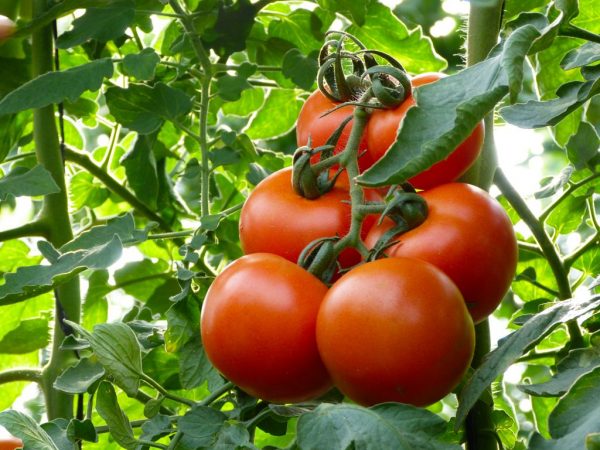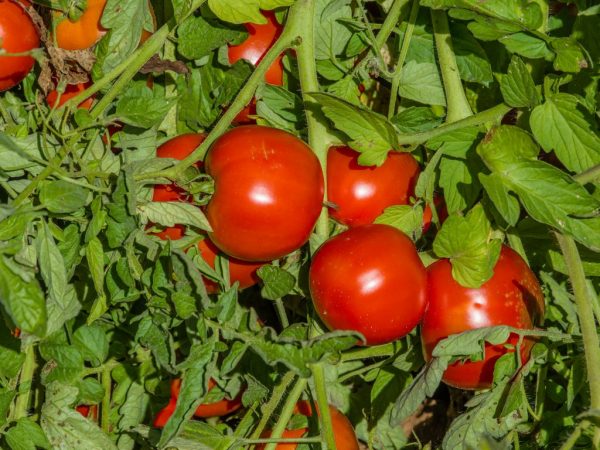Description of Mahitos tomato
The Mahitos tomato has been particularly popular among gardeners and agronomists for many years. The Mahitos f1 tomato was loved for its undemanding care and high yield.

Description of Mahitos tomato
Characteristics of the variety
Tomato Mahitos f1 was introduced in Holland. A large number of breeders from all over the world worked on its creation. Initially, the tomato was created for cultivation exclusively in greenhouses. It is forbidden to plant it in open ground, since temperature changes negatively affect the final result.
To date, Mahitos F1 tomatoes are not included in the State Register of the Russian Federation.
Cultivation is possible in all regions of the country.
Description of the plant
According to the description, the Mahitos f1 tomatoes are medium early. It ripens in 100 days from the period of emergence of the first shoots and belongs to indeterminate, that is, it has unlimited growth. Its height can reach 2 m.
The foliage is a rich dark green color, medium in size, so air and sun rays penetrate to the soil surface. It is important to pay attention to the fact that the stem is quite tall, so it is important to regularly tie it to a support. According to reviews, the yield will be much higher if you form a bush in 1 stem.
Description of the fetus
Mahitos tomatoes are round in shape. At some points, there may be a slight flattening. It all depends on the quality of the purchased seeds. The description of the hybrid tomato Mahitos says that its surface is smooth to the touch. The peel has a deep red color. All ripe fruits have the same shape and are collected in small clusters.
According to their characteristics, Mahitos tomatoes are quite large. The weight of an individual ripe fruit can reach 300 g. When ripe, tomatoes do not crack, which increases the shelf life. The taste is pleasant, with slight notes of sweetness. The pulp is firm, not watery. The amount of dry matter reaches 7%. The yield of Mahitos tomatoes is quite high. From 1 sq. m. gardeners and agronomists collect about 5 kg of fruits of the highest quality. According to its characteristics, the Mahitos tomato variety is versatile in preparation and use. It is great both for fresh consumption and for preservation for the winter period.
Benefits
A large number of positive qualities of the species are noted. From a number of advantages, the main indicators can be distinguished:
- rich, pleasant, sweet taste;
- yield and the ability to collect fruits several times per season;
- tolerance to any climatic conditions;
- high performance of the immune system;
- the possibility of long-term storage and transportation;
- versatility in use;
- excellent performance indicators.
disadvantages

The plant is sensitive to cool weather
The main disadvantages of the species include:
- the color sometimes acquires green spots;
- inflorescences die during freezing, so you need to carefully monitor the airing time of the greenhouse.
Landing rules
When growing a Mahitos tomato, you should pay attention to the quality of the soil: the further development of the plant and the future harvest depend on it. The first step is to create an ideal seedbed. For these purposes, humus, peat, sand and ordinary garden soil are used. All ingredients are mixed in equal proportions, after which seeds are planted there. The soil is pre-treated with a weak solution of manganese so that pests do not start.
Seeds are placed to a depth of no more than 1 cm. A distance of 4 cm is maintained between individual containers.
The distance between the rows should be at least 10 cm. After planting, the containers are recommended to be covered with plastic wrap and left in this position for several days. The temperature in the greenhouse must be at least 25 ° C. After several leaves appear on the seedlings, it should be planted in separate personal containers. In this case, the distance between the rows should be at least 100 cm, and between the holes - 40 cm.
Care
Until the first shoots are formed, the seeds should receive a sufficient amount of oxygen. For this purpose, the film is removed every day for half an hour. The main thing is to monitor the temperature regime. The temperature should not be lower than 20 ° C. If the soil begins to dry out slowly, it needs to be watered with a little water.
You also need to monitor the level of illumination. If the landing occurred at a time when the day lasts less than 12 hours, additional lighting devices should be installed. Watering should be frequent, done every 3 days, but not abundantly, otherwise the root system will rot. Also carry out the formation of a bush in 2 stems. The amount of mineral fertilizers is minimized. The garter is carried out when the plant is just gaining growth.
Do not forget about removing unnecessary leaves. Only those that prevent the sun's rays from reaching the fruit are removed. Pruning is carried out in hot climates so that moisture cannot evaporate. For tomatoes to have a rich solid color, substances containing potassium or magnesium are used.
Prophylaxis
This type of vegetable has a strong immune system, and therefore diseases such as tobacco mosaic, nematode, cladosporia and verticillosis cannot spread to it.
If you maintain the correct temperature and light conditions, the plant will acquire resistance to various parasites and pests, but for this you need to carefully monitor all indicators and monitor them daily, otherwise, this can lead not only to the emergence of parasites, but also to the death of the plant itself.
Conclusion
As you can see, the variety needs human attention. Caring for him is standard, does not require much time. The main thing is to carefully monitor the conditions in the greenhouse, then the yield will surprise with quality and quantity. You just need to take into account the requirements for planting and care.


